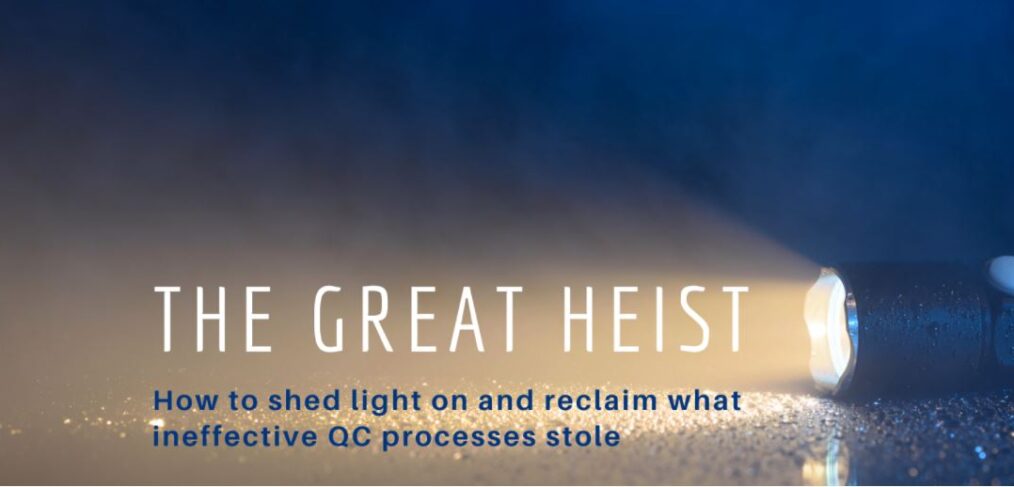
The Great Heist: How to shed light on and reclaim what ineffective QC processes stole.
Many mortgage companies are being robbed and don’t even know it. This culprit hides in plain sight, inconspicuously draining the organization from within. A brilliant, if not ruthless, villain! For an industry regulated so heavily, how can this happen? Given that much of this bad actor’s activities are perceived as “normal”, they usually move about undetected. But it is time to expose the heist, arrest the thief, and reclaim what was stolen.
But this thief is not a person, it is an ineffective business process.
As will be discussed, a Quality Control department (or “QC”, a unit within the traditional second line of defense in a mortgage company’s compliance management system) can steal from an organization in many surprising ways. So where do we begin?

Identify what was stolen and fight to get it back
Like any good caper, knowing what went missing is the first step. Once identified, We must then work to reclaim what was stolen. Given that every organization is different, there is no one-size-fits-all list. However, based on our experience* there are three items that commonly go missing at the hands of ineffective QC, including:
1. TRUST from key stakeholders.
2. IMPACT from meaningful findings.
3. VALUE from report timeliness.

#1: Absence of trust or buy-in
What was stolen & how it happened
Trust is a currency more valuable than cash. When that account is depleted, key stakeholders begin questioning the value of the process and eventually dis-engage. Lack of trust can stem from many sources. Here are just a few:
- QC results not revealing the issues that operators know already exist,
- Inflexible processes producing carbon-copy findings that are not helpful,
- Over-burdensome requests to lines of business,
- A ”gotcha” mentality that points fingers instead of offering a helping hand,
- Perception of box-checking instead of risk managing.
Getting it back. Reclaiming lost trust
To expose and eliminate this foe, we must first realize that trust with key stakeholders is a bank account that can never be overdrawn. This can be done by:
- Revising testing scripts/ methodology or hiring/ outsourcing subject matter experts,
- Adjusting procedures, timelines, or other processes to better fit the needs of the business unit (based on their feedback),
- Self-serving documents and information where possible and adjusting testing scope based on risk and reasonableness,
- Incentivizing QC staff differently. Encourage accuracy and timeliness vs. completion.
#2: Missing real problems IS the problem.
What was stolen & how it happened
Meaningful problems (errors or findings representing significant unmitigated risk) can sneak by undetected and go un-corrected when QC is not staffed by independent subject matter experts. These findings are like gold; Valuable, rare, and require sifting through a lot of nothing to unearth. These nuggets are stolen during “sifting” process when:
- The QC team (in-house or outsource) is outwitted by the line of business during the rebuttal period,
- Over-broad testing misses the detail and thus, the problem,
- Out-dated testing is asking the wrong question (and getting the wrong answer),
- Corrective action plans, if any, have no teeth and no oversight, creating a perpetual loop of findings without improvement.
Beyond the obvious compliance liability of missed findings, improperly removed findings are a silent drain on profitability, productivity and it further diminishes the department’s (or vendor’s) reputation. Talk about a costly theft!
Getting it back: Reclaiming lost impact from missed findings
- Dedicate 1 full-time equivalent (FTE) to regulation change implementation within the QC testing team (applicable in most cases),
- Ask someone in each operational area being tested to complete the testing script. Hint: be ready to jot down a laundry list of gaps.
- Recruit true subject matter experts into QC to hold business units accountable. This is where an out-sourced provider is either a huge help or a big hindrance. It takes one to know one!
- Keep an ongoing inventory of agreed-upon corrective actions. Regularly hold operations accountable to specific timelines and outcomes (not just loan-level fixes).
#3: Timeliness (time value of findings)
What was stolen and how it happened
QC’s delays debilitate. We’ve all seen it. The October QC reports that arrive in March, ouch! The value of these findings (and thus the QC department’s value to the organization) diminish greatly the longer it takes final results to reach key stakeholders. The theft is compounded by the withdrawal from the “trust” account that took place when such outdated information is provided for decision making (or lack thereof).
“What good is this report that tells me everything I needed to fix four months ago? Plus, I already fixed it.” — Most servicing managers.
Getting it back. Reclaiming lost value from timely findings
This issue may seem easy to correct, but in our experience, it’s the hardest. Why? Delays and missed timelines are often a symptom of systemic problems. The cure is found in two elusive attributes: persistence and willingness/ability to change.
Falling behind is easy and getting caught up is hard, so even vendors can fall victim. In outsourced relationships and internal processes alike, there is only so much pestering one can do to create the momentum required to move in the desired direction, let alone see actual improvement. So, while the fight is an uphill one, here are some ideas to consider:
- Outsource or switch vendors. Sometimes, the easiest answer is just asking someone else.
- Impose monetary penalties or dire consequences for missed timelines (i.e., COO must sign off on any QC report timeline extension request).
- Increase capacity through well-qualified hires (in-house only).
- Increase throughput by solving known bottlenecks (testing scripts, document chasing, etc.).
- Reduce complex processes down to a lower common denominator. Find (or carve out) something in the most complex process that “anyone could do” and delegate it.
Conclusion
By reclaiming the three most common items stolen by ineffective Quality Control, an organization measurably increases ROI, improves performance, boosts morale, and impresses regulators.
At BridgeRM, we believe that no company should settle for an uncertain future. To learn more about our Mortgage Quality Control and Risk Management capabilities, please contact Taylor Hildenbrand at +1 405.938.1305 or Taylor@BridgeRM.com

BridgeRM is a privately held risk management, consulting, and outsourcing company. Since 2009, BridgeRM has worked with mortgage companies and other businesses nationwide to prevent and solve chaos through transformative risk management solutions.
By combining unrivaled experience with an emphasis on practical implementation, BridgeRM collaborates with clients to achieve lasting results that help their organization thrive.
Editor’s note
There is no one-size-fits-all solution to risk management. This article is for information purposes only and not intended to be an all-inclusive prescription. Your situation may be different. We welcome your feedback and the opportunity to help you uncover more clues in your journey towards reclaiming what ineffective QC may have stolen from your organization.



